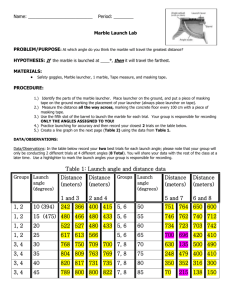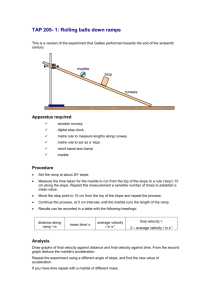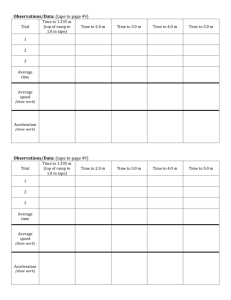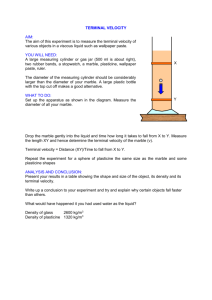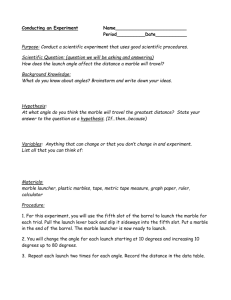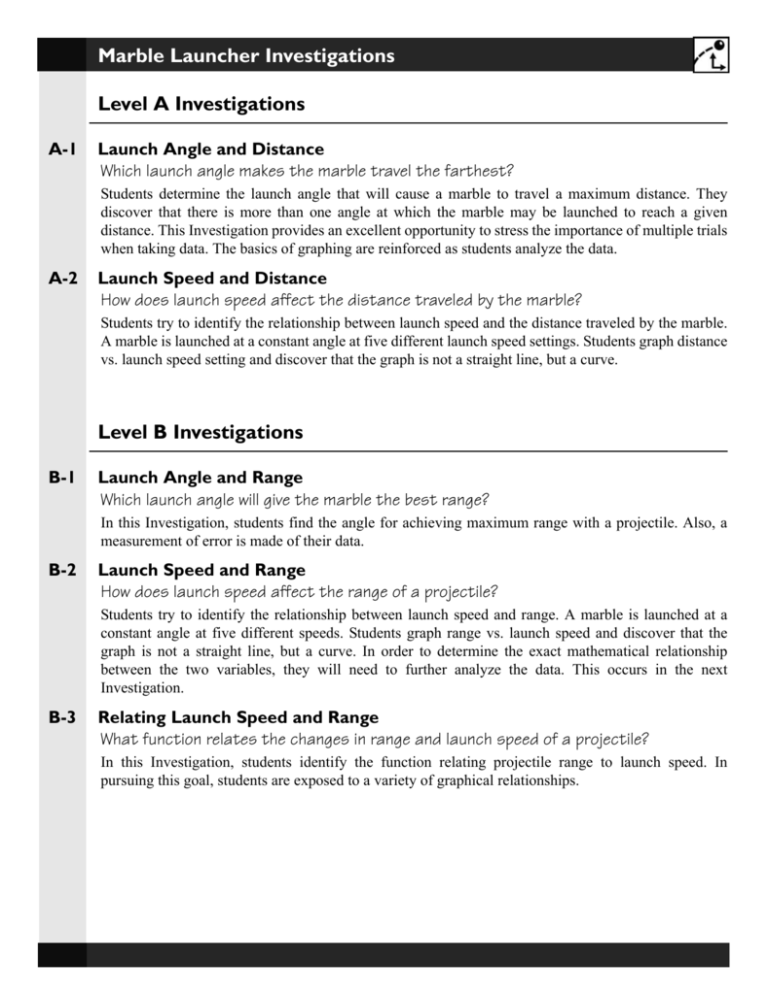
Marble Launcher Investigations
Level A Investigations
A-1
Launch Angle and Distance
Which launch angle makes the marble travel the farthest?
Students determine the launch angle that will cause a marble to travel a maximum distance. They
discover that there is more than one angle at which the marble may be launched to reach a given
distance. This Investigation provides an excellent opportunity to stress the importance of multiple trials
when taking data. The basics of graphing are reinforced as students analyze the data.
A-2
Launch Speed and Distance
How does launch speed affect the distance traveled by the marble?
Students try to identify the relationship between launch speed and the distance traveled by the marble.
A marble is launched at a constant angle at five different launch speed settings. Students graph distance
vs. launch speed setting and discover that the graph is not a straight line, but a curve.
Level B Investigations
B-1
Launch Angle and Range
Which launch angle will give the marble the best range?
In this Investigation, students find the angle for achieving maximum range with a projectile. Also, a
measurement of error is made of their data.
B-2
Launch Speed and Range
How does launch speed affect the range of a projectile?
Students try to identify the relationship between launch speed and range. A marble is launched at a
constant angle at five different speeds. Students graph range vs. launch speed and discover that the
graph is not a straight line, but a curve. In order to determine the exact mathematical relationship
between the two variables, they will need to further analyze the data. This occurs in the next
Investigation.
B-3
Relating Launch Speed and Range
What function relates the changes in range and launch speed of a projectile?
In this Investigation, students identify the function relating projectile range to launch speed. In
pursuing this goal, students are exposed to a variety of graphical relationships.
Level C Investigations
C-1
Projectile Motion and the Range Equation
How can you predict the range of a projectile?
In this Investigation, students derive an equation that allows them to predict the range of the marble
given the initial velocity and launch angle. First, they derive the range equation, then they test their
predictions. Finally, they compare theoretical predictions to actual measurements using a range vs.
launch angle graph.
C-2
Improving the Range Equation
How can you improve the range equation?
In this Investigation, students correct the inconsistencies in the range equation they derived previously.
They discover that the differences between theory and actual measurements are due to the fact that the
marble is actually launched above the floor and the range equation assumes that it is launched at floor
level. They use a quadratic equation to correct for this height difference.
C-3
Accuracy, Precision, and Error
How repeatable are experiments with the marble launcher?
Students determine the accuracy and precision of the marble launcher experiments. They launch the
marble ten times at the same launch angle and initial velocity onto a sheet of grid paper covered by
carbon paper. From this, they create a target plot that shows the average deviation of all landings from
the average. As a challenge, students apply what they learned by playing “shoot your own grade” using
a target they create.
C-1
Projectile Motion and the Range Equation
C-1
Question: How can you predict the range of a launched marble?
In this Investigation, you will find and test a model that will predict the range of the marble from
the initial velocity and launch angle.
You have learned that the motion of any object moving through the air
affected only by gravity is an example of projectile motion. Examples of
projectile motion include a basketball thrown toward a hoop, a car driven
off a cliff by a stunt person, and a marble launched from the CPO marble
launcher. Projectile motion is also called two-dimensional motion because
it depends on two components: vertical and horizontal. In this
Investigation, you will determine a mathematical model (the range
equation) that predicts the range of the marble given launch angle and
initial velocity.
A
Analyzing the motion of the marble in two dimensions
How can you predict the range of the marble? Since gravity pulls down and not sideways, the motion
of the marble must be separated into components. It makes sense to pick one component (y) in the
vertical direction aligned with gravity. The other component (x) is then chosen to be in the horizontal
direction, perpendicular to the force of gravity. The diagram below shows the velocity of the marble
(v) at three points in its trajectory, resolved into x and y components, vx and vy.
a.
b.
Use the diagram above to explain why projectiles travel in a curved path called a trajectory.
How does the marble’s velocity in x change over the time of the flight? How does its velocity in y
change over the time of flight?
1
B
Understanding the velocity equations
C-1
The object of this Investigation is to find and test a model that will predict the range of the marble from
the initial velocity and launch angle—the range equation.
a.
The first step is to separate the velocity of the marble into x and
y components. Use the triangle formed by velocities (at right) to
express vx and vy in terms of the initial velocity, v, and the sine
and cosine of the launch angle, θ.
When the initial velocity is separated into x and y components, Equations 1a-2b give the relationships
between the motion variables separately for x and y. In these equations the subscript i refers to the
initial values at launch.
Equations 1a and 1b are for the marble’s velocity while equations 2a and 2b are for the marble’s
position.
Equation 1a
Equation 1b
b.
vx = vxi + ax t
v y = v yi + a y t
Equation 2a
1
x = xi + vxit + ax t 2
2
Equation 2b
1
y = yi + v yi t + a y t 2
2
Since gravity does not pull up or sideways, one of the accelerations (ax, ay) is -g, and the other is zero.
For the first approximation, the range (x) is defined so the initial x and y positions are also zero.
Rewrite Equations 1a-2b leaving out terms that are zero and substituting your previous results for vxi
and vyi.
Equation 1a:
Equation 1b:
Equation 2a:
Equation 2b:
c.
d.
2
The purpose of this exercise is to find a theory that predicts where the marble will land (the range, x)
given the initial velocity and launch angle. This problem can be solved in several steps. First, assume
that gravity acts only on the y component of velocity. Solve for the time it takes the marble to reach its
maximum height (where vy = 0).
Since gravity does not pull sideways, the x component of the marble's velocity is not affected and
remains constant. Use Equation 2a to calculate the range (x) from vxi and the total time of flight (this
will be the range equation).
C
Setting up the marble launcher
C-1
1. Attach one photogate to the
marble launcher so that the
marble breaks the light beam
as it comes out of the barrel.
Put the timer in interval mode,
and connect the photogate to
input A. The launcher can
launch at angles from 0
(horizontal) to 90 degrees
(vertical). For this experiment,
you will use angles from 0 to
80 degrees.
The photogate attaches to the
tab on the end of the wood
piece that supports the barrel.
Be sure the light beam crosses
the center of the barrel.
2. Use a strip of masking tape on
the floor to make sure that the
marble launcher is consistently
placed in the same location. A
tape measure laid along the
floor provides a good range
reference.
3. To launch marbles, pull the
launching lever back and slip it
sideways into one of the slots.
Put a marble in the end of the
barrel and the marble launcher
is ready to launch.
4. There are five notches that
change the compression on the
spring and give different
launch speeds. In this
experiment, you will change
the launch speed setting for
different launches.
SAFETY RULES:
• Never launch marbles at people.
• Wear safety glasses or other eye protection when launching marbles.
• Launch only the black plastic marbles that come with the marble launcher.
3
D
Doing the experiment
1. To check your theory, a spread of data for different launch angles and initial velocities will be
needed. For each spring setting you should have five different launch angles from 20 degrees to 80
degrees. To cover both variables (angle and speed), at least 20 data points are needed.
2. A minimum of two people are needed per launcher. One person launches the marbles and the other
person/people watches where they land.
3. Use only the black plastic marbles provided by CPO.
4. Record the spring setting, launch angle, time from photogate A, and measured range for each
launch. It often takes several launches with the same setup to locate the landing point precisely. For
each setup, you may need to run several trials until the measured range is consistent within 5 cm.
5. Calculate the initial velocity by dividing the distance traveled (width of marble = 0.019 m) by the
time at photogate A. Record initial velocities in the table. A larger version of the table is found on
your answer sheet.
Spring setting (1 - 5):
Launch angle
Range
(degrees)
(m)
E
C-1
Distance
(m)
0.019
0.019
0.019
0.019
0.019
Time from A
(sec)
Initial velocity
(m/sec)
Comparing theory predictions to measured data
Use the table to help you compare your measured data to theory predictions using your range equation.
Fill in several launch angles for each initial velocity. A larger table is found on your answer sheet.
Initial velocity
(m/sec)
a.
b.
c.
4
Launch angles (degrees)
x (predicted)
x (measured)
Make a graph showing the range vs. launch angle for several
different initial velocities. The graph at right is one example of
how this graph could look. You could also choose other ways to
graph the data. Plot the measured points as unconnected dots and
the theoretical values as solid lines since the theory predicts the
speed of the marble at all points.
How does your theory compare with your measurements? In
particular, is there a consistent deviation between theory and
experiment? The word “consistent” means the difference
between the theoretical and experimental data seems to depend on something in the experiment and is
not random. For example, a consistent deviation would occur if the measured range for small angles is
always smaller than predicted by theory regardless of the velocity. Explain how the consistent
deviations you found are affected by velocity and angle.
Consistent deviations indicate that something is missing from the theory. What is missing, and why
does it have the observed effect on your results?
Name:
C-1
Projectile Motion and the Range Equation
C-1
Question: How can you predict the range of a launched marble?
A
Analyzing the motion of the marble in two dimensions
a.
Use the diagram to explain why projectiles travel in a curved path called a trajectory.
b.
How does the marble’s velocity in x change over the time of the flight? How does its velocity in y
change over the time of flight?
B
Understanding the velocity equations
a.
Use the triangle formed by velocities to express vx and vy in terms of the initial velocity, v, and the sine
and cosine of the launch angle, θ.
b.
Rewrite Equations 1a-2b leaving out terms that are zero and substituting your previous results for vxi
and vyi.
Equation 1a:
Equation 1b:
Equation 2a:
Equation 2b:
c.
The purpose of this exercise is to find a theory that predicts where the marble will land (the range, r)
given the initial velocity and launch angle. This problem can be solved in several steps. First, assume
that gravity acts only on the y component of velocity. Solve for the time it takes the marble to reach its
maximum height (where vy = 0).
d.
Since gravity does not pull sideways, the x component of the marble's velocity is not affected and
remains constant. Use Equation 2a to calculate the range (r) from vxi and the total time of flight (this
will be the range equation).
C-1 Projectile Motion and the Range Equation
Answer Sheet
C
Setting up the marble launcher
C-1
SAFETY RULES:
• Never launch marbles at people.
• Wear safety glasses or other eye protection when launching marbles.
• Only launch the black plastic marbles that come with the marble launcher.
D
Doing the experiment
Spring setting (1 - 5):
Launch angle
(degrees)
Range
(m)
Distance
(m)
Time from A
(sec)
Initial velocity
(m/sec)
Time from A
(sec)
Initial velocity
(m/sec)
0.019
0.019
0.019
0.019
0.019
Spring setting (1 - 5):
Launch angle
(degrees)
Range
(m)
Distance
(m)
0.019
0.019
0.019
0.019
0.019
C-1 Projectile Motion and the Range Equation
Answer Sheet
Part 4 Data Table, Continued
C-1
Spring setting (1 - 5):
Launch angle
(degrees)
Range
(m)
Distance
(m)
Time from A
(sec)
Initial velocity
(m/sec)
Time from A
(sec)
Initial velocity
(m/sec)
0.019
0.019
0.019
0.019
0.019
Spring setting (1 - 5):
Launch angle
(degrees)
Range
(m)
Distance
(m)
0.019
0.019
0.019
0.019
0.019
C-1 Projectile Motion and the Range Equation
Answer Sheet
E
Comparing theory predictions to measured data
C-1
Use the table to help you compare your measured data to theory predictions using your range equation.
Fill in several launch angles for each initial velocity.
Initial velocity
Launch angles (degrees)
(m/sec)
x (predicted)
x (measured)
x (predicted)
x (measured)
x (predicted)
x (measured)
x (predicted)
x (measured)
x (predicted)
x (measured)
C-1 Projectile Motion and the Range Equation
Answer Sheet
C-1
a.
Make a graph showing the range vs. launch angle for several different initial velocities. The graph at
right is one example of how this graph could look. You could also choose other ways to graph the data.
Plot the measured points as unconnected dots and the theoretical values as solid lines since the theory
predicts the speed of the marble at all points.
b.
How does your theory compare with your measurements? In particular, is there a consistent deviation
between theory and experiment? The word “consistent” means the difference between the theoretical
and experimental data seems to depend on something in the experiment and is not random. For
example, a consistent deviation would occur if the measured range for small angles is always smaller
than predicted by theory regardless of the velocity. Explain how the consistent deviations you found are
affected by velocity and angle.
c.
Consistent deviations indicate that something is missing from the theory. What is missing, and why
does it have the observed effect on your results?
C-1 Projectile Motion and the Range Equation
Answer Sheet
Questions
C-1
1.
A marble launcher is set up on the floor using notch 3 and an angle of 45
degrees. The marble is launched and the range is measured. The launcher
is then taken off the floor and put on a nearby table. It is again set for
notch 3 and 45 degrees. Will the two flights be the same or different?
Explain your answer.
2.
Sketch the vector triangles showing the initial velocity
and the x and y components for each of the three
launch angles shown. Using your diagrams, explain
why the marble launched at 45 degrees goes the
farthest.
3.
Where along the trajectory is the vertical component of the velocity of the marble zero? Circle this
place on the marble’s path.
4.
The marble launcher is set up with an angle of 80 degrees, and the timer measures 0.0030 seconds for
the 0.019 m marble. Calculate the expected range (x) of the marble.
C-1 Projectile Motion and the Range Equation
Answer Sheet
Curriculum Resource Guide: Marble Launcher
Credits
CPO Science Curriculum Development Team
Author and President: Thomas Hsu, Ph.D
Vice Presidents: Thomas Narro and Lynda Pennell
Writers: Scott Eddleman, Mary Beth Abel, Lainie Ives, Erik Benton and
Patsy DeCoster
Graphic Artists: Bruce Holloway and Polly Crisman
Curriculum Contributors
David Bliss, David Lamp, and Stacy Kissel
Technical Consultants
Tracy Morrow and Julie Dalton
Curriculum Resource Guide: Marble Launcher
Copyright
2002 Cambridge Physics Outlet
ISBN 1-58892-047-X
2 3 4 5 6 7 8 9 - QWE - 05 04 03
All rights reserved. No part of this work may be reproduced or transmitted in any form or by an means,
electronic or mechanical, including photocopying and recording, or by any information store or retrieval
system, without permission in writing. For permission and other rights under this copyright, please contact:
Cambridge Physics Outlet
26 Howley Street,
Peabody, MA 01960
(800) 932-5227
http://www.cpo.com
Printed and Bound in the United States of America


